First time to Japan trip planning can be overwhelming at times, especially if you are from a Western country or a place that has a completely different culture.
Chances are you might find the transportation system in Japan particularly the train system to be a tad confusing.
Or the local etiquettes that are best followed and applied when you are in this fascinating foreign land.
In short, you want to fully prepare for your first trip to Japan by learning at least the basic essential knowledge about Japanese travel.
But if you have a tight personal life schedule with minimal time to spare, spending hours researching Japan’s travel tips for first time visitors seems to be out of reach.
Fret not, I have got your back!
Make sure to read this comprehensive list of 45 useful travel tips for first time travelers to Japan till the end so that you can better plan the trip and eventually have a blast exploring the country with the slightest effort.
So let’s dive in.
Related Posts:
- 21 Best Mt Fuji Ryokan With Private Onsen (+Gorgeous Views!) In 2023
- Top 11 Kyoto Photography Tours In 2023 (+ Real Reviews!)
- Top 23 Snacks In Japan To Try (And Where To Get Them)
- Japan Ski Packing List: What To Pack & Useful Tips
- Day Trip To Nara—The Ultimate Nara Itinerary One Day
- 1 Day Itinerary Osaka—The Best Itinerary To Explore Osaka In 24 Hours
- The Perfect Kyoto 2-Day Itinerary—Epic Guide To Explore Kyoto
- Best 4 Days Tokyo Itinerary: How To Spend 4 Days In Tokyo
- Best Day Trip To Hakone From Tokyo: The Ultimate Guide
Disclaimer: This page may contain affiliate links and I may get a small commission if you decide to make a purchase through my links, at no additional cost to you. Thank you.
What Do I Need To Know Before Traveling To Japan
- Finding Cheap Flights To Japan
- Make Accommodations Booking Earlier
- Bring Along Travel Adaptor
- English Is Not Widely Spoken
- Learn Simple Japanese Phrases
- Wear Slip-On Shoes
- Buy Japan Rail Pass Before Flying To Japan
- Download Helpful Japan Travel Apps
- Rent A Wifi Device
- Buy A Suica Card
- Pay The Bus Fare When Alighting
- Stand On The Left Wherever You Go
- Renting Cars Tips In Japan
- Look Out For Women-Only Train Carriages
- Refrain From Speaking On Phone In Public
- Luggage Storage In The Train
- Leave The Taxi Door Alone
- Take Screenshot Of Japanese Address
- Keep The Trash With You
- Experience The Lively Japanese Cities’ Nightlife
- Buy Attraction Tickets Online Fuss-Free
- Arrive At Popular Attractions Early In The Morning
- Mask Wearing By The Japanese
- Etiquette At Shrines and Temples
- Bring Enough Cash
- Save Money Through Tourist Tax Refund
- Place Your Money On The Tray
- Bring Several Debit Cards
- Opt For At Least A Night’s Stay In Ryokan
- Cover Your Tattoos
- Learn Onsen Etiquette
- Do Not Point Using Fingers
- Do Not Blow Your Nose
- Smoke At Designated Areas
- Refrain From Eating While Walking
- Indulge On Cheap Food In Convenience Stores
- Brace For Long Queue
- Menus Are Mainly In Japanese
- Make A Hearty Slurp Sound While Eating Noodle
- Indoor Smoking Is Allowed In Certain Restaurants
- Do Not Stick The Chopstick Upright Into The Meal
- Tipping Is Not Needed
- Check Out The Futuristic Japanese Toilets
- Bring Along Hand Sanitiser
- Safety In Japan
Traveling To Japan For The First Time: 45 Useful Tips
1. Finding Cheap Flights To Japan
Flights to Japan can be expensive at times, especially during peak seasons.
To get your hands on cheaper flight tickets to Japan, you can check out Skyscanner.
This handy website compares the prices, flight duration, and operators on the same page, making the hunt for low-cost Japan flight tickets a total breeze.
2. Make Accommodations Booking Earlier
Among the top things to do for people who travel to Japan for the first time is getting their accommodation in Japan sorted earlier.
You can easily do so through Booking.com or Agoda.
Spring and autumn are peak travel seasons in Japan thanks to the beautiful cherry blossoms and fiery autumn foliage.
The accommodation rooms can be fully booked as early as two months before the individual season commences.
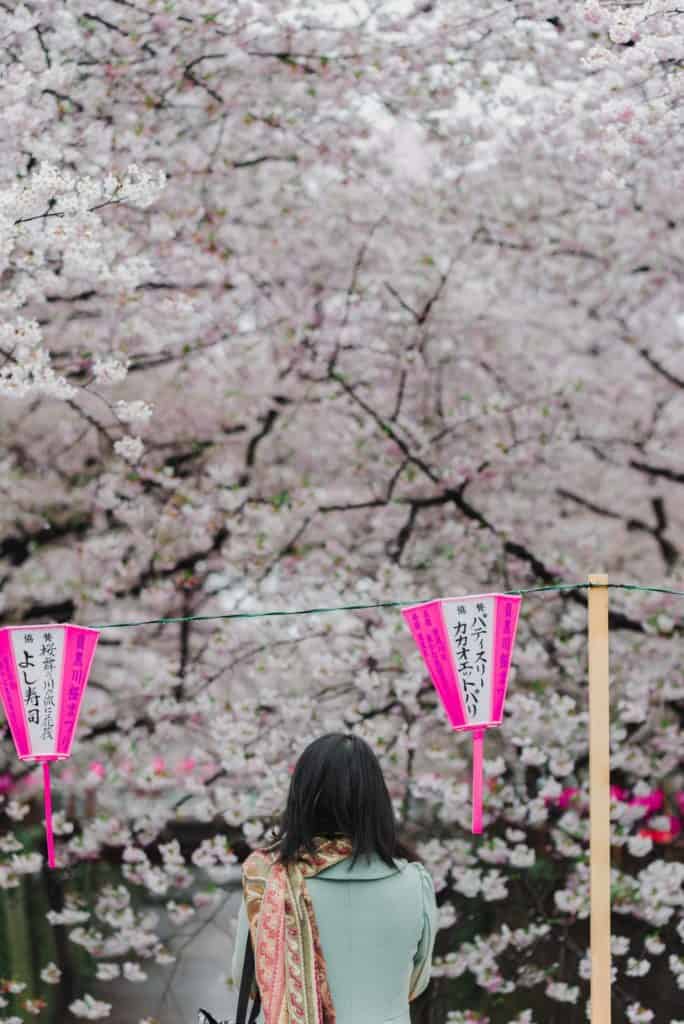
In summer, most local families will travel to different parts of Japan as it is also the school holiday season.
And during the winter season, popular onsen resorts such as Hakone are filled with tourists looking for an enjoyable onsen session with a charming snowy view.
So to avoid disappointment and last-minute plan change, make sure to get your accommodation booked earlier.
3. Bring Along Travel Adaptor
This is a survival tip—make sure to get a travel adaptor before flying into Japan!
In Japan, most electrical outlets are Type A which have only two flat pins.
This Universal Travel Adaptor is a great travel buddy to have wherever you go, including your first time in Japan.

4. English Is Not Widely Spoken
Though most road signages and ticketing machines in bigger cities come in both English and Japanese, most urban locals do not usually converse in English.
You might even face some difficulties in communicating with the residents as you venture into the smaller outskirt towns.
But fret not.
Japanese are very kind and polite and go all out to help international travelers when being approached nicely.
Alternatively, you can use simple hand signs or use online translation apps to convey your questions to them.
5. Learn Simple Japanese Phrases
It helps to learn several simple Japanese phrases before visiting Japan for the first time.
When you greet the locals with these phrases, they will appreciate your effort and might even give you some additional travel tips to better explore the local region.
Here are some of the Japanese greetings to practice on:
- Hello – Konnichiwa
- Good morning – Ohayou gozaimasu
- How are you – O genki des ka
- Excuse me – Sumimasen
- Thank you – Arigato gozaimasu
6. Wear Slip-On Shoes
Removal of shoes to enter into certain establishments in Japan is a common practice.
These places include shrines, temples, private homes, and even some restaurants.
To prevent yourself from developing backache due to the constant tying up of shoelaces, your best bet is to get yourself a pair of good slip-on shoes before reaching Japan.
Slip-on shoes offer easy shoe removal and putting on and hence more time to squeeze additional activities in the itinerary.

Travel tip: Bring several pairs of comfortable, hole-free socks along too!
7. Buy Japan Rail Pass Before Flying To Japan
Japan Rail (JR) Pass is an unmissable pass to get if you plan to explore at least three Japanese cities on your first time to Japan travel.
JR pass allows international visitors to get to different cities at a cheaper price with a short travel duration.
The best part is the user can have unlimited rides on the shinkansen (bullet train) within the pass validity.
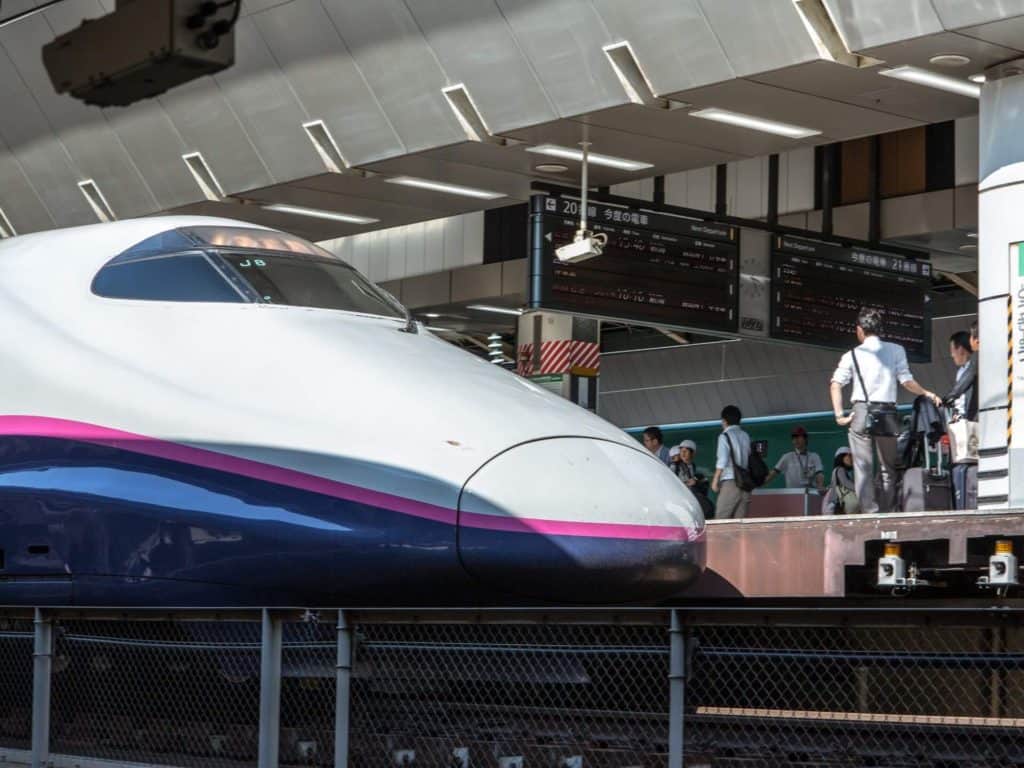
You can simply buy the pass online and have it shipped over to your residence at zero cost.
And once you are ready to activate the JR pass, just head over to the counter and you are set to go!
8. Download Helpful Japan Travel Apps
Traveling to Japan for the first time can be overwhelming, particularly when you are surrounded by a foreign language, culture, and system.
Hence to make your first trip to this country a memorable one, it is best to download some helpful Japan travel apps before your flight.
These travel apps range from transportation, navigation, language translation, and so much more.
And the great thing about these apps is that you can download most of them for free!
Travel tip: You can check out my best apps for travel to Japan article so that you can better plan for the trip!
9. Rent A Wifi Device
Chances are you need a stable Internet connection to use the Japan travel apps to navigate around, communicate with the locals, and so much more.
That is especially true for those who are flying for the first time to Japan without any prior local experience.
Modern metropolises such as Tokyo and Osaka might offer local wifi hotspot services to visitors.
But as you wander further away to rustic off the beaten path places of Japan, it is recommended to have a wifi device with you to navigate around without getting lost.
10. Buy A Suica Card
If you prefer convenience when boarding the public trains, subways, and buses for the first time trip in Japan, book a prepaid rechargeable card like Suica.
Instead of getting individual train tickets when reaching different stations, you can just tap the Suica card at the train entrance gate to get in.
The Suica card can also be used in certain stores, most vending machines, or even restaurants for payment.
11. Pay The Bus Fare When Alighting
There are two ways of paying the bus fare in Japan; either using coins or using a rechargeable card such as Suica.
If you are using a Suica Card, you can just tap the card machine when boarding the bus via the rear entrance.
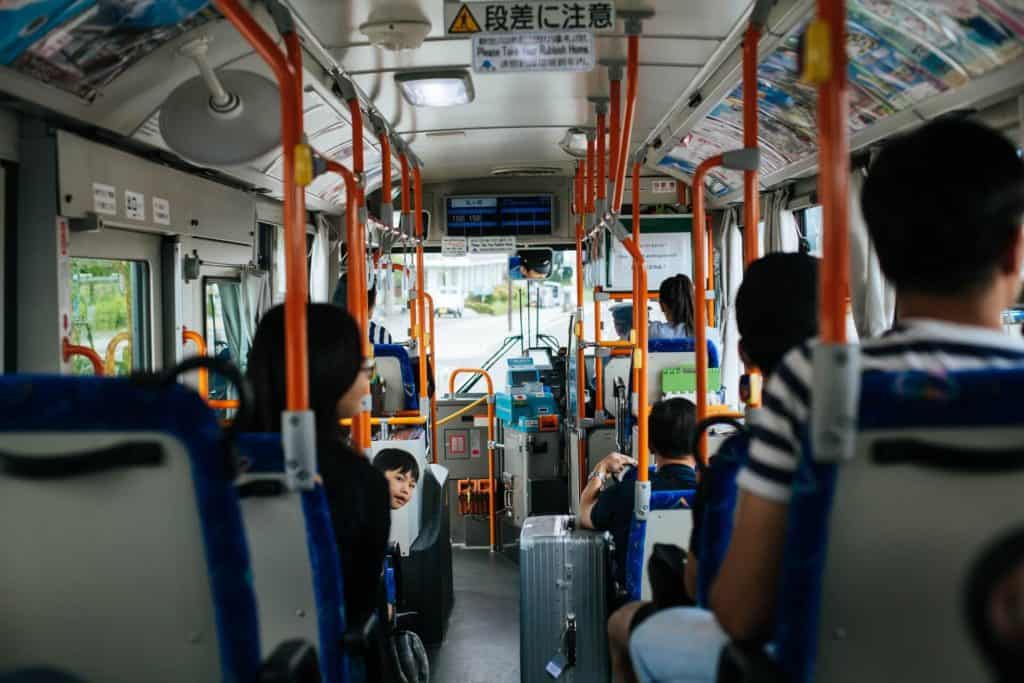
Once you reach the intended bus stop, walk towards the driver and tap the card once again at the reader placed next to the driver, and exit via the front door.
For coin payers, take a numbered bus ticket from the machine next to the door as you board.
And before you alight, compare the ticket number with numbers on the bus display board to determine the fare.
Prepare the exact fare amount and drop it into the box located near to the driver as you alight through the front door.
Travel tip: If you are taking a city bus service with flat fare instead, pay the fare as you board through the front door and alight via the back door.
12. Stand On The Left Wherever You Go
Another stare-invoking behavior that a first time traveler to Japan should not do is standing on the wrong side of the escalator.
This is particularly important when you are in Tokyo train stations during rush hours.
Thousands of local workers flock to the station daily to commute to their workplaces with a quick pace and large stride.
Most of them walk up and down the escalator and standing on the wrong escalator side can easily earn you some angry stares.
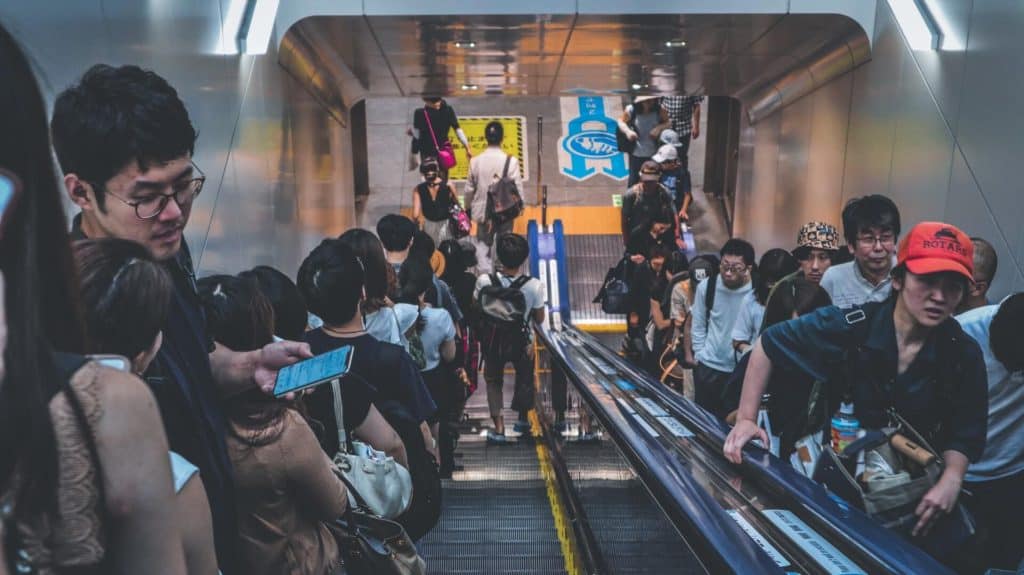
So make sure to stand on the left wherever you go and those in a hurry can bypass you without any hard feelings.
Travel tip: In Osaka, its escalator culture is to stand on the right. So it is recommended to take note and observe the local region’s culture and just follow accordingly.
13. Renting Cars Tips In Japan
As a starter, you can rely on Japanese public transportation systems when exploring the major cities.
But if you plan to get to rural towns with a group of people during your first time traveling to Japan, renting a car might be the better alternative.
Here are some useful tips to know:
- Driver to have a valid International Driving Permit
- Vehicles drive on the left side
- GPS systems in certain rental companies are not available in English
- Gas stations are either full or self-service
- Parking is typically free in small town
Travel tip: Make sure to do some research on the car rental companies and select the one that suits your preference.
Alternatively, you can consider renting car from rentcars.
14. Look Out For Women-Only Train Carriages
This first time to Japan travel tip is specifically dedicated to male international travelers.
There are women-only train carriages in certain trains in Tokyo catered to female passengers during rush hours of morning and evening.
You can easily identify this special carriage with the eye-catching pink mark with “Women Only” wordings.
Apart from the ladies, these carriages are also permissible to elementary school boys, handicapped passengers, and their male caretakers.
15. Refrain From Speaking On Phone In Public
As you read along with this article, you will find out that Japan is indeed a beautiful cultural country with many unique etiquettes.
One of them is to refrain from speaking on the phone in public.
You can sense the lack of noise on public transport even when the locals rush in and out during the rush hours in big metropolitan cities.
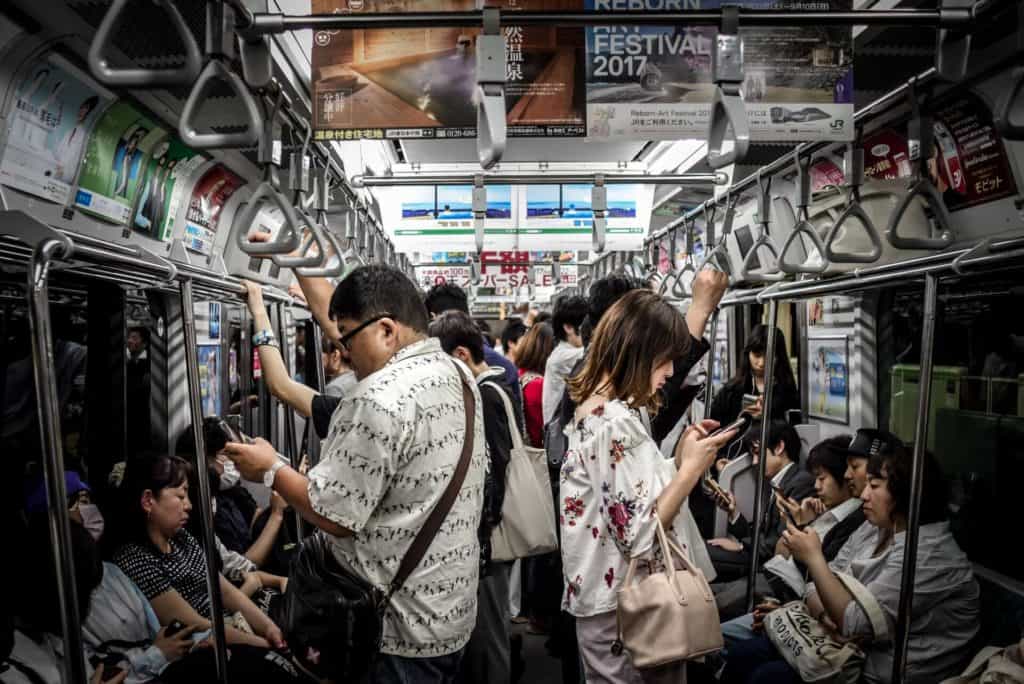
That’s because the Japanese are a big advocate of not invading people’s privacy or creating disturbance to the public.
And so if you do not wish to get annoyed stares from fellow passengers, make sure not to talk on the phone or to anyone while taking public transport.
Get yourself a brand new Bluetooth earbuds to listen to your fav playlist while travelling from one place to another via the train or bus services in Japan.

16. Luggage Storage In The Train
In Japan, most trains do not have a dedicated space for storing big luggage.
While smaller bags can be placed on the overhead rail, you can shift the bigger ones to the last row of each train carriage.
Alternatively, some train stations offer luggage storage lockers so you can store yours before hopping onto the train for a day trip or two in other Japanese cities.
Travel tip: Airport trains like Narita Express have designated spacious storage areas for luggage.
17. Leave The Taxi Door Alone
If you hail a taxi in Japan, most likely you do not need to open the door yourself.
That’s because the taxi driver will open the door automatically for you by pressing some buttons.
Well, welcome to Japan.
Once you are inside the taxi, the door will be automatically closed by the driver too before leaving for the intended destination.
And this repeats when you have reached your destination—the driver-operated door will open and close without you lifting any finger.
18. Take Screenshot Of Japanese Address
Japanese addresses can be slightly complicated at times.
Your nervousness might be exacerbated especially when you have difficulty in pronouncing them to the locals to get to the place.
Hence your best bet is to save a screenshot of the building names or addresses and show them instead.
It is time to make full use of your electronic gadgets especially when you visit Japan for the first time.
Alternatively, you can consider keeping the premise’s business card.
This tip works very well on getting back to your hotel room when each street that you pass by in Japan looks too identical to you.
Bring along a portable charger to ensure your phone does not run out of battery from snapping pictures while you are exploring the country.

19. Keep The Trash With You
Trash bins are a rare sight in Japan.
You can hardly find a trash bin even while exploring the Japanese cities, including Tokyo.
So the best way to handle the trash is to keep it in a plastic bag and bring it back to your hotel room for disposal.
Travel tip: If you are lucky, you might stumble upon a trash bin in certain convenience stores.
20. Experience The Lively Japanese Cities’ Nightlife
Though some of the Japanese major highlights are best visited during the day, you can still find plenty of interesting things to do to experience the cities’ nightlife.
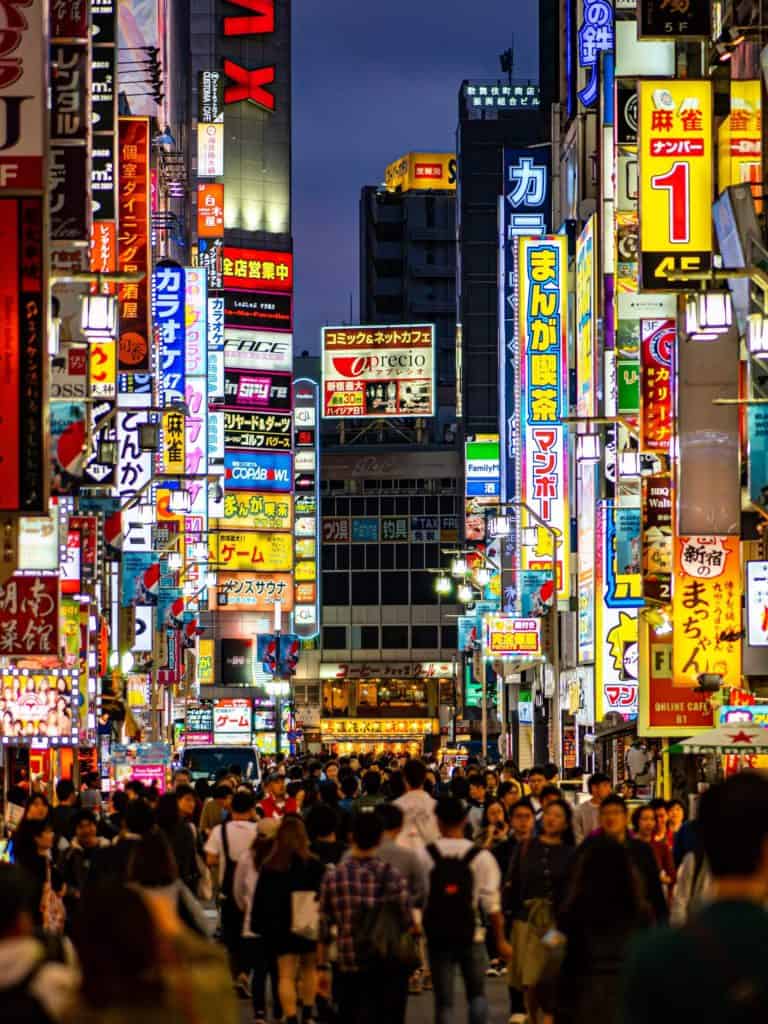
Some of the popular things to do among international tourists include:
And if you are staying in Osaka and Kyoto, check out my detailed articles on Osaka and Kyoto unmissable night activities for a fun night out!
21. Buy Attraction Tickets Online Fuss-Free
As mentioned in the previous tip, there are so many interesting things to do in Japan.
These activities range from temple-hopping, skyline admiring, theme park adventures, museum-visiting, and so much more.
Since these delightful attractions put Japan out on the world map as among the top travel destinations, you can expect long queues forming at the ticketing counter of each attraction.
So to save time from queuing for more time to immerse into each activity, it is recommended to buy the attraction tickets online.
Besides, online tickets are mostly sold at a cheaper price too.
And that means more money saved to spend on another bowl of noodles in Japan!
22. Arrive At Popular Attractions Early In The Morning
Japan attracts millions of visitors annually thanks to its numerous beautiful and one-of-a-kind highlights.
With this in mind, your best bet is to arrive at the popular attractions early in the morning to skip the crowd.
This is especially true when you plan to visit Kyoto Instagrammable photo spots to have a snap or two.
Sometimes, you might even need to queue for an hour-long just to get your photos taken at the tourist-flocking sites.
If you are traveling to Japan for the first time in summer, arriving at the must-visit highlights early in the morning also warrants a better overall travel experience while the heat is still minimal.
Get yourself a camera bundle to take nice, high-quality pictures in Japan as memento!

23. Mask Wearing By The Japanese
Japanese have the habit of wearing masks before hitting the road.
This scene is more frequently seen on most locals during hay fever season in Japan.
Apart from that, some locals put on masks as a part of fashion accessories making their appearance more trendy.
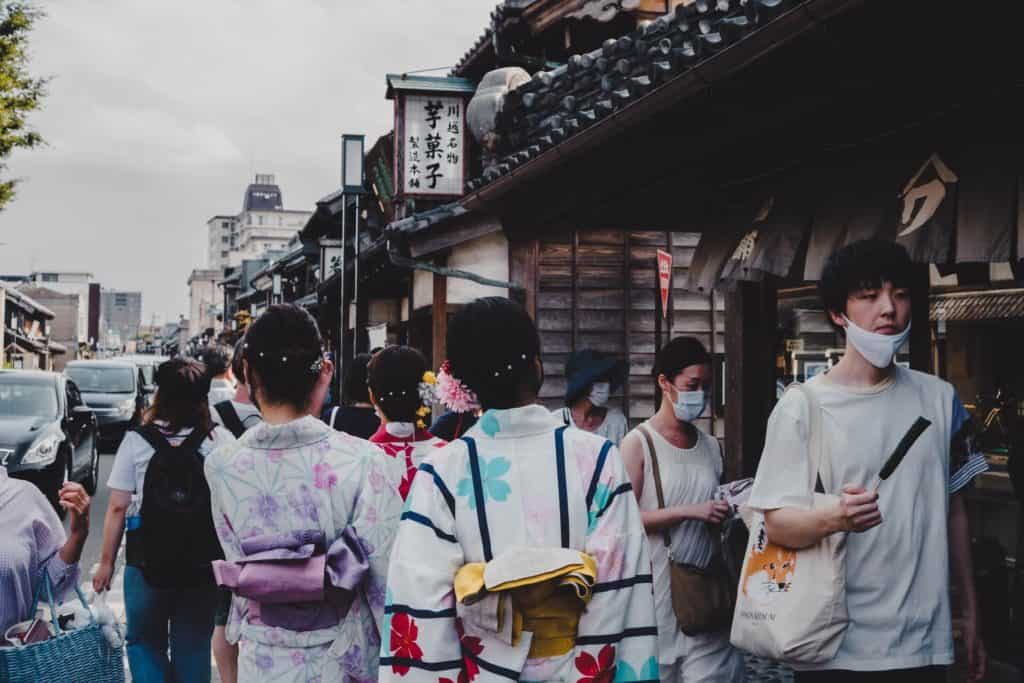
24. Etiquette At Shrines and Temples
As mentioned earlier, there are many places in Japan where shoes need to be removed before entering the premises.
You can expect to do so when you are entering Japanese shrines and temples.
Depending on the worship places rule, visitors are requested to either:
- Leave their shoes at the entrance or
- Put their shoes in a plastic bag and bring them along while walking around
Though there is no official dress code to follow to visit shrines and temples, it is recommended to dress modestly and be respectful by not being loud within the premises.
25. Bring Enough Cash
Not all establishments in Japan accept card payment.
So it is recommended to have cash with you at all times, especially when you are visiting the rustic parts of the country.
Get yourself a travel wallet where you can keep ample cards and cash together for convenience.

26. Save Money Through Tourist Tax Refund
As a foreign traveler, you can save some money via tourist tax refund at eligible stores.
Firstly, you will need to spend a minimum of 5000 yen in the same store.
Then visit the tax refund counter and hand over your passport with the receipt to the receptionist.
You will be asked to fill up a tax refund form and voila free money to splurge on other stuff.
Travel tip: Make sure to get a copy of the receipt of purchase from the counter. The receipt will be collected by the immigration officer before leaving Japan.
27. Place Your Money On The Tray
You might come across a small tray placed on the counter while you are in the store or restaurant.
If that is so, you can place the money on the tray.
The tray allows the cashier to have a contactless transaction with the customer.
Besides, this minimizes the chance of coins dropping to the floor while passing over the money hand-to-hand and inevitably causing a long queue for the next customer.
28. Bring Several Debit Cards
You can withdraw local money from the ATMs using foreign debit cards located in most convenience stores and post offices in Japan.
However, there are times when certain cards are not accepted by the machines.
So it is good to have several debit cards with you when traveling to Japan for the first time.
29. Opt For At Least A Night’s Stay In Ryokan
If you have the budget to splurge for at least a night’s stay in a ryokan, make sure it is on your top to-do list.

Ryokan is a Japanese traditional style inn that offers a chance for visitors to experience the truly authentic way of living of the Japanese.
With traditional components ranging from tatami floor, futon bed, delicious kaiseki meal, and onsen, you are bound to have a wonderful first time Japan adventure.
Check out these ryokans when you are planning your trip to major cities in Japan:
- Tokyo: Ryokan Ichinao, Ryokan Katsutaro
- Osaka: Yamatoya Honten Ryokan Osaka, Kaneyoshi Ryokan
- Kyoto: Ryokan Kyoraku, Ohanabo
30. Cover Your Tattoos
Tattoos are still pretty much a big taboo in Japan.
You might receive raised eyebrows from the Japanese if your tattoo is visible while exploring the country.
If you are inked, it is recommended to have it covered with a bandage or an additional layer of cover-up sleeve.

31. Learn Onsen Etiquette
Japan is known for its relaxing onsen or hot spring bath.
This uniquely Japanese experience is a must-try activity especially for first time travelers.
However, there are several unnegotiable onsen etiquettes to follow before dipping into the mineral-rich water.
The major onsen etiquette that can make your eyes go big and your heart go wild is that you must be completely naked to enjoy the session.
If you are up for the intriguing experience, make sure to go through the onsen etiquette manual and follow it religiously.
Travel tip: Some onsens deny entry to inked visitors so it is best to check the onsen policy first before getting there.
32. Do Not Point Using Fingers
In Japan, finger-pointing is considered a rude and unpleasant gesture.
If you want to ask for directions or inquire about something, you can wave your hand instead.
33. Do Not Blow Your Nose
Another important tip to know when traveling for the first time to Japan is not to blow your nose in public.
This seemingly normal act in Western countries is frowned upon by the Japanese as it is thought to be bad manners.
And this brings us to the next question, “Don’t the Japanese blow their noses”?
The answer is a yes and as usual, by following the Japanese way.
You can either sniffle your mucus continuously or you can blow your nose in the toilet quietly.
34. Smoke At Designated Areas
If you are looking to have some nicotine puffs for a break from sightseeing activity, make sure to head over to designated areas to do so.
In Tokyo, smoking while walking or out of the designated smoking area is punishable with hefty fines by the local authorities.
This is to reduce the exposure of unhealthy, second-hand smoke to the public.
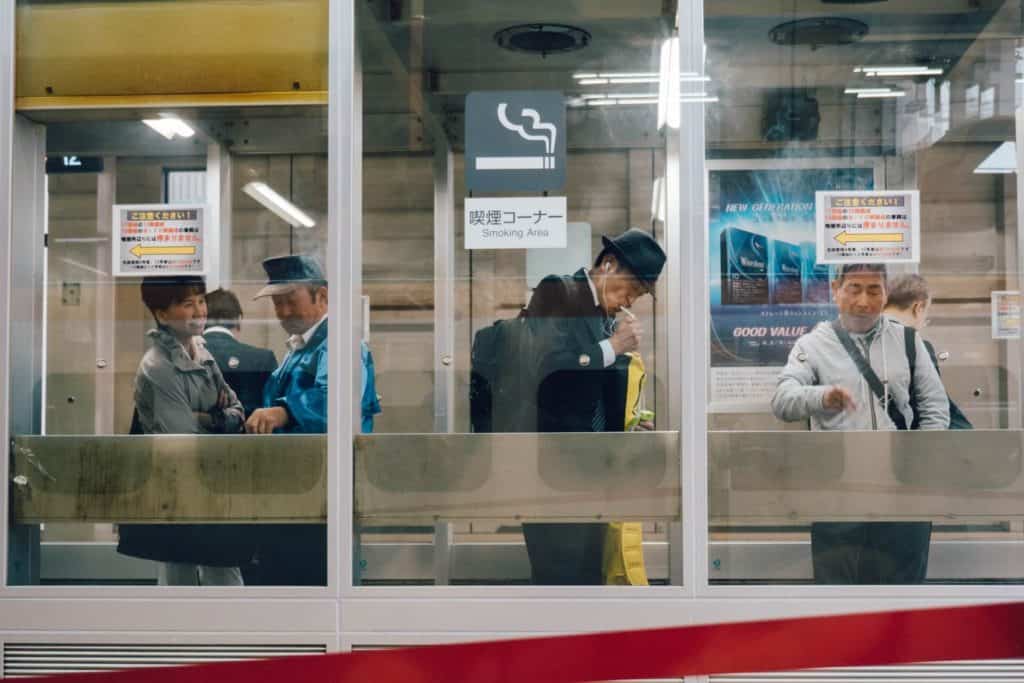
35. Refrain From Eating While Walking
You can find many food-related local etiquettes that are best followed while you are in Japan.
When you are wandering along the shotengai (covered arcade) or streets to have your local food fare craving fixed, it is recommended to refrain from eating while continuing to walk around.
Apart from reducing the mess caused by eating while walking, this behavior is frowned upon by the Japanese.
That is because you would not be able to enjoy the food properly if you were to engage in another activity at the same time.
So get your food, step aside, and pick a spot to indulge before resuming your sightseeing or food-hunting activity.
36. Indulge On Cheap Food In Convenience Stores
Convenience stores in Japan are on another level.
You can find a variety of affordable yet fulfilling meals with a wide range of drinks options available in the stores.

Apart from these, there are also many visually-catching Japanese snacks to munch on for a stay-in night.
37. Brace For Long Queue
Long queues are a normal occurrence in Japan.
You can expect to see this scene especially at popular eatery establishments in Tokyo and Osaka or in major international events like Comiket.
The locals are instilled with important virtues including respect and discipline since young.
And to show respect to other people, the Japanese stay in line and wait for their turn patiently even if the queue spans several blocks away.
38. Menus Are Mainly In Japanese
You will realize most menus in the eatery establishments are mainly in Japanese words with zero or limited English translation.
Nevertheless, most food items come with photos so you can still identify the general ingredients used in the meal visually before placing the order.
Alternatively, you can utilize phone apps such as Google Translate to translate the food name and description into your preferred language for additional clarity.
39. Make A Hearty Slurp Sound While Eating Noodle
Feel free to make a hearty slurp sound while indulging in a bowl of noodle soup in Japan.
This yet another unique Japanese culture might sound weird to most foreign visitors.
To the locals, the slurping action makes the noodle tastier and to enjoy the food before it turns soggy.
If making the loud slurp noodle sound is not your kind of thing, that is fine too.
But if you are traveling to Japan for the first time, you need to try doing this at least once when visiting the noodle booth.
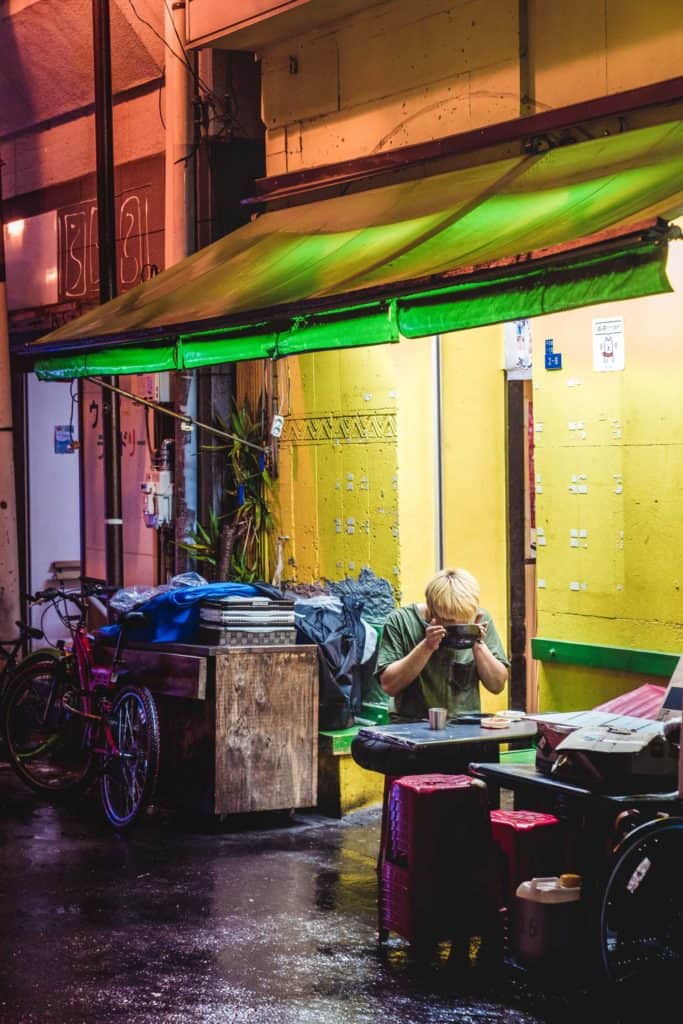
40. Indoor Smoking Is Allowed In Certain Restaurants
Though Japan has started to implement indoor smoking bans in most establishments, there are some restaurants allowing customers to smoke indoors.
You can easily differentiate them by looking at the smoking sign at the store entrance.
41. Do Not Stick The Chopstick Upright Into The Meal
One of the most crucial table manners that a first time traveler to Japan needs to know is the Japanese chopsticks etiquette.
The most common etiquette is not sticking the chopstick upright into the meal.
That’s because the Japanese typically stick the chopstick into a bowl of rice as an offering to the dead on the altar.
If you are doing this in the restaurant, it will be considered disrespectful and thought to be bringing bad luck.
Travel tip: You can lay down the chopsticks on their holder. Most restaurants provide chopstick holders for their patrons.
42. Tipping Is Not Needed
Tipping culture might be a norm in Western countries but definitely not in Japan.
Japanese take pride in performing their jobs well and sometimes, tipping can be considered as an insult by some.
43. Check Out The Futuristic Japanese Toilets
If you are flying for the first time to Japan, this brilliant Japanese invention needs to be on your to-use list.
The Western-style Japanese toilets might look and sound complicated to some, (especially the international travelers) but they come with some cool functions.
Apart from having a built-in bidet to wash your backside, the high-tech toilet also has a music button aiming to conceal any noise in the cubicle.
Travel tip: You can also find Japanese-style (squatting required) toilets mostly in the rural parts of Japan.
44. Bring Along Hand Sanitizer
The majority of public toilets in Japan do not provide soap to the users.
So if you fall into the hygiene-prioritized group of first time travelers to Japan, make sure to get yourself a hand sanitizer.

Travel tip: You can hardly find paper towels in the public toilets too. Hence, bring some pocket tissues with you before leaving your hotel room.
45. Safety In Japan
As a first time traveler to Japan, you will be glad that Japan is a relatively safe country to visit.
Nevertheless, it is always a good practice to be alert to your surroundings and explore with precaution.
Besides, make sure to always keep your belongings at sight, especially in crowded places.

FAQ: First Time In Japan
1. How long does it take to go to Japan for the first time?
Japan is a beautiful country with lots of charming attractions to offer to fellow visitors.
Hence, we recommend that you stay at least two weeks for your first trip to Japan.
With this, you will have ample time to explore the country at your pace including those must-visit cities and also some rustic towns.

2. Where should I go first time in Japan?
For first time travelers to Japan, you can include Tokyo, Osaka, and Kyoto into your itinerary.
These cities are easily reachable with shinkansen (bullet train), making them among the popular spots to visit whenever one is in Japan.
Check out my Japan 3 Week Itinerary to have some ideas on Japanese cities to explore, things to do, and mouth-watering cuisine that you should not miss!
3. What is the best time to visit Japan?
The best time to visit Japan is in spring (March to May) and autumn (September to November).
In spring, you will get to enjoy the lovely view of cherry blossoms and in autumn the vibrant fall foliage scenery.
Nevertheless, it is also worth noting that these peak seasons attract large tourist crowds; both local and international.
Additional Resources Before Traveling To Japan
If you want to learn more about planning your first time to Japan trip and Japanese culture in general, make sure to check out these books:
- Fodor’s Essential Japan Travel Guide
- Japan: Highlights of a Fascinating Country
- Japan’s World Heritage Sites: Unique Culture, Unique Nature
- Japan: The Essential Guide to Customs & Culture
- Be More Japan: The Arts Of Japanese Living

First Time To Japan: Conclusion
Here you go—the 45 best travel tips that you can rely on for your first time in Japan!
Do you have any other travel tips to share with me? Let me know; I would love to hear from you!
If you find this article useful, I will be very appreciative if you can share it with your family members and friends.
Or if you are planning to travel to Japan for the first time soon, make sure to save this helpful Japanese travel tip article for easy reference.

Sam Lee, founder of Sam Lee Travel, is a seasoned traveler with over 10 years of experience exploring various Asian countries. Having lived in Singapore for almost a decade, Sam has developed a deep understanding of the culture, customs, and attractions in the region.
With a passion for outdoor travel adventures and water sports, Sam has helped over 25K readers per month plan their trips around Asia, including off-the-beaten-path destinations, offering helpful travel tips and unfiltered personal travel experience.
